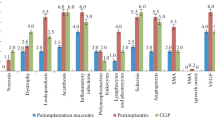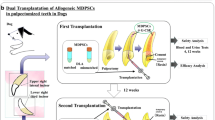Abstract.
Responses of immunocompetent cells to tooth replantation during the regeneration process of the dental pulp in rat molars were investigated by immunocytochemistry using antibodies to class II major histocompatibility complex (MHC) molecules (OX6 antibody), monocyte/macrophage lineage cells (ED1 antibody) and protein gene product 9.5 (PGP 9.5), as well as by histochemical reaction for periodic acid-Schiff (PAS). Tooth replantation caused an increase in both the number of OX6- and ED1-positive cells and their immunointensity in the replanted pulp, but almost all PGP 9.5-immunoreactive nerves diminished in the initial stages. By postoperative day 3, many OX6- and ED1-immunopositive cells had accumulated along the pulp-dentin border to extend their cytoplasmic processes into the dentinal tubules in successful cases. Once reparative dentin formation had begun after postoperative day 7, OX6- and ED1-immmunopositive cells became scattered in the odontoblast layer, while reinnervation was found in the coronal pulp. The temporal appearance of these immunocompetent cells at the pulp-dentin border suggests their participation in odontoblast differentiation as well as in initial defense reactions during the pulpal regeneration process. On postoperative day 14, the replanted pulp showed three regeneration patterns: (1) reparative dentin, (2) bone-like tissue formation, and (3) an intermediate form between these. In all cases, PAS-reactive cells such as polymorphonuclear leukocytes (PML) and mesenchymal cells occurred in the pulp space. However, the prolonged stagnation of inflammatory cells was also discernible in the latter two cases. Thus, the findings on PAS reaction suggest that the migration of the dental follicle-derived cells into the pulp space and the subsequent total death of the proper pulpal cells are decisive factors for eliciting bone-like tissue formation in the replanted pulp.
Similar content being viewed by others
Author information
Authors and Affiliations
Additional information
Electronic Publication
Rights and permissions
About this article
Cite this article
Shimizu, A., Nakakura-Ohshima, K., Noda, T. et al. Responses of immunocompetent cells in the dental pulp to replantation during the regeneration process in rat molars. Cell Tissue Res 302, 221–233 (2000). https://doi.org/10.1007/s004410000263
Received:
Accepted:
Issue Date:
DOI: https://doi.org/10.1007/s004410000263




